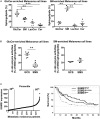Sphingomyelin Synthase 1 (SMS1) Downregulation Is Associated With Sphingolipid Reprogramming and a Worse Prognosis in Melanoma
- PMID: 31114500
- PMCID: PMC6503817
- DOI: 10.3389/fphar.2019.00443
Sphingomyelin Synthase 1 (SMS1) Downregulation Is Associated With Sphingolipid Reprogramming and a Worse Prognosis in Melanoma
Abstract
Sphingolipid (SL) metabolism alterations have been frequently reported in cancer including in melanoma, a bad-prognosis skin cancer. In normal cells, de novo synthesized ceramide is mainly converted to sphingomyelin (SM), the most abundant SL, by sphingomyelin synthase 1 (SMS1) and, albeit to a lesser extent, SMS2, encoded by the SGMS1 and SGMS2 genes, respectively. Alternatively, ceramide can be converted to glucosylceramide (GlcCer) by the GlcCer synthase (GCS), encoded by the UGCG gene. Herein, we provide evidence for the first time that SMS1 is frequently downregulated in various solid cancers, more particularly in melanoma. Accordingly, various human melanoma cells displayed a SL metabolism signature associated with (i) a robust and a low expression of UGCG and SGMS1/2, respectively, (ii) higher in situ enzyme activity of GCS than SMS, and (iii) higher intracellular levels of GlcCer than SM. SMS1 was expressed at low levels in most of the human melanoma biopsies. In addition, several mutations and increased CpG island methylation in the SGMS1 gene were identified that likely affect SMS1 expression. Finally, low SMS1 expression was associated with a worse prognosis in metastatic melanoma patients. Collectively, our study indicates that SMS1 downregulation in melanoma enhances GlcCer synthesis, triggering an imbalance in the SM/GlcCer homeostasis, which likely contributes to melanoma progression. Evaluating SMS1 expression level in tumor samples might serve as a biomarker to predict clinical outcome in advanced melanoma patients.
Keywords: cancer; ceramide; glucosylceramide; prognosis biomarker; sphingolipids.
Figures


References
-
- Bilal F., Peres M., Le Faouder P., Dupuy A., Bertrand-Michel J., Andrieu-Abadie N., et al. (2017b). Liquid chromatography-high resolution mass spectrometry method to study sphingolipid metabolism changes in response to CD95L. Methods Mol. Biol. 1557 213–217. 10.1007/978-1-4939-6780-3_20 - DOI - PubMed
LinkOut - more resources
Full Text Sources
Other Literature Sources
Medical
Research Materials

